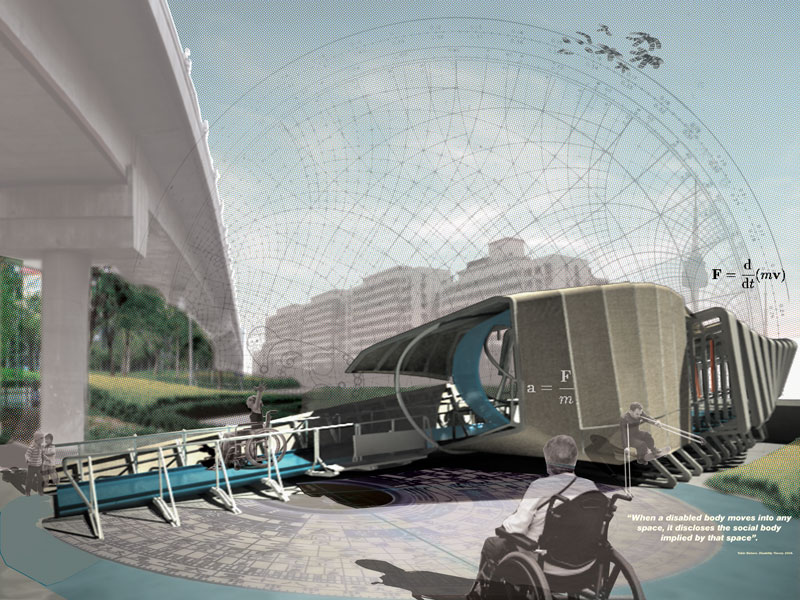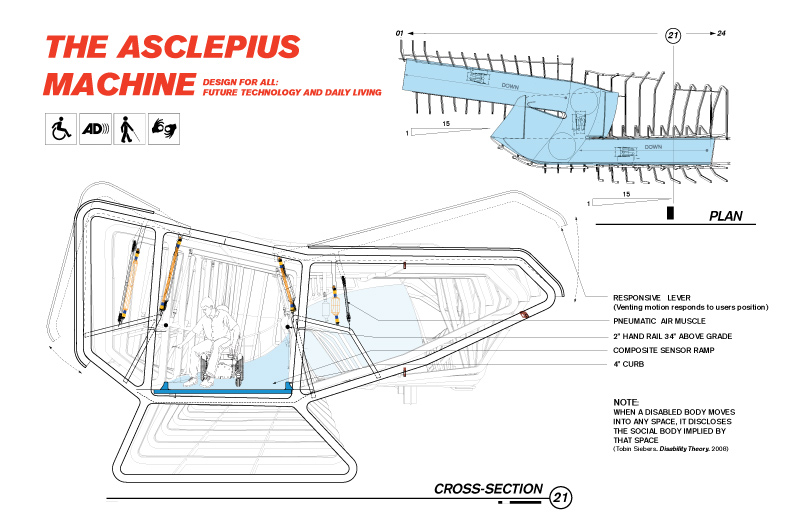
the asclepius machine: genetic diversity and extreme urban euphoria (resubmit with video) by robert adams from usa
designer's own words:
The Asclepius Machine is an exuberantly designed wheelchair accessible ramp and computationally pervasive architecture. The Asclepius Machine is to the 21st century what the arcade was to the 19th century – an animated passage – a civic infrastructure and space capable of producing extreme urban euphoria. In contrast to the passive labor of 20th century infrastructure designed with a singular understanding of fitness and beauty through frictionless auto-mobile bodies avoiding the more extreme capacities of the human experience, the Asclepius Machine is a complex and interactive environment thriving among human technological and mechanical diversity. Located between the scale of furniture and a pedestrian bridge, the Asclepius Machine animates and extends the operative range of our bodies. If assistive devices such as motorized wheelchairs or white canes for the seeing impaired are mechanical extensions of a sensing body, the Asclepius Machine is a biomechanical hybrid between mechanized bodies and extreme urban environments. Unlike most wheelchair ramps and other accessible forms of infrastructure that perform simply in service to those with so-called special needs, the Asclepius Machine is a performance vehicle that exceeds necessity, and motivates a more robust understanding of how our collective genetic diversity contributes to the vitality of everyday life.
The fear of pain, loss of gender identity, and the unease of the grotesque body have incapacitated the agency of architecture to produce spatial models that broaden the expectations of the social body further isolating the disabled body. The primary drive of this work is to co-produce urban machines that rethink and network civic infrastructure, genetic diversity and disability constraints to improve the quality of our lives in the ephemera of architecture as an ancient form of locative media. The design seeks to extend the range of architecture’s capacity to enroll a more intricate understanding of the public sphere to the extreme limits of perception regardless of bodily ability. The objective of this work is to reconfigure cultural codes through producing devices, formal structures and pervasive environments that advocate for a more actionable and responsive architecture that does not simply ameliorate or re-engineer the perceived challenges of disability, but that produces a wider range of civic paradigm empowering design for all.
The Asclepius Machine: Rendering the Scene = Sensation + Atmosphere. A simple bridge or sidewalk is charged with a deeper responsibility in producing civic enterprise. Extreme bodies demand extreme architecture.
 The Asclepius Machine: Drawing Out = Mechanics + Telemetry. Structurally, 24 frames support the ramp and air muscles. Similar to our own body mechanics, one muscle contracts while the other extends operating the lever.
The Asclepius Machine: Drawing Out = Mechanics + Telemetry. Structurally, 24 frames support the ramp and air muscles. Similar to our own body mechanics, one muscle contracts while the other extends operating the lever.